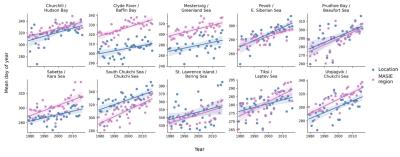Sea Ice Indicators for Users of Arctic Coastal Environments
Drawing on remote sensing data and community-based observations of the seasonal sea-ice cycle, indicators of freeze-up and break-up have been developed for users of ice-covered coastal and shelf regions in the Arctic and sub-Arctic. The study provides a detailed analysis of different indicators and metrics and identifies key trends at the local and regional levels.
The derivation of key indicators of the seasonal sea ice-cycle derived from satellite data and informed by community-based observations provide an opportunity to assess the impacts of sea ice trends and changes from the perspective of local communities and their use of the coastal environment. The analysis of resulting trends as compared to different satellite data sets with near pan-Arctic coverage supports the refinement of earth-system modeling frameworks that need to capture such processes at the relevant temporal and spatial scales.
Locally based metrics were used to construct indicators of breakup and freeze-up in Arctic and subarctic coastal environments. The indicators developed are based on daily sea ice concentrations derived from satellite passive-microwave measurements. The “day of year” indicators are designed to optimize value for users while building on past studies characterizing breakup and freeze-up dates in the open pack ice and providing spatial fields of key sea ice seasonal events to validate earth system modeling efforts. Relative to indicators for broader adjacent seas, the coastal indicators generally show later breakup at sites known to have landfast ice. The coastal indicators also show earlier freeze-up at some sites in comparison with freeze-up for broader offshore regions, likely tied to earlier freezing of shallow-water regions and areas affected by freshwater input from nearby streams and rivers. A factor analysis performed to synthesize the local indicator variations shows that the local breakup and freeze-up indicators have greater spatial variability than corresponding metrics based on regional ice coverage. However, the trends towards earlier breakup and later freeze-up are unmistakable over the post-1979 period in the synthesized metrics of coastal breakup and freeze-up and the corresponding regional ice coverage. The findings imply that locally defined indicators can serve as key links between pan-Arctic or global indicators, such as sea ice extent or volume and local uses of sea ice, with the potential to inform community-scale adaptation and response.

